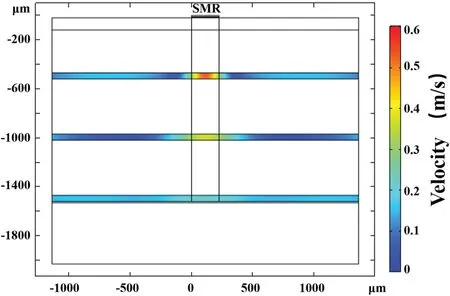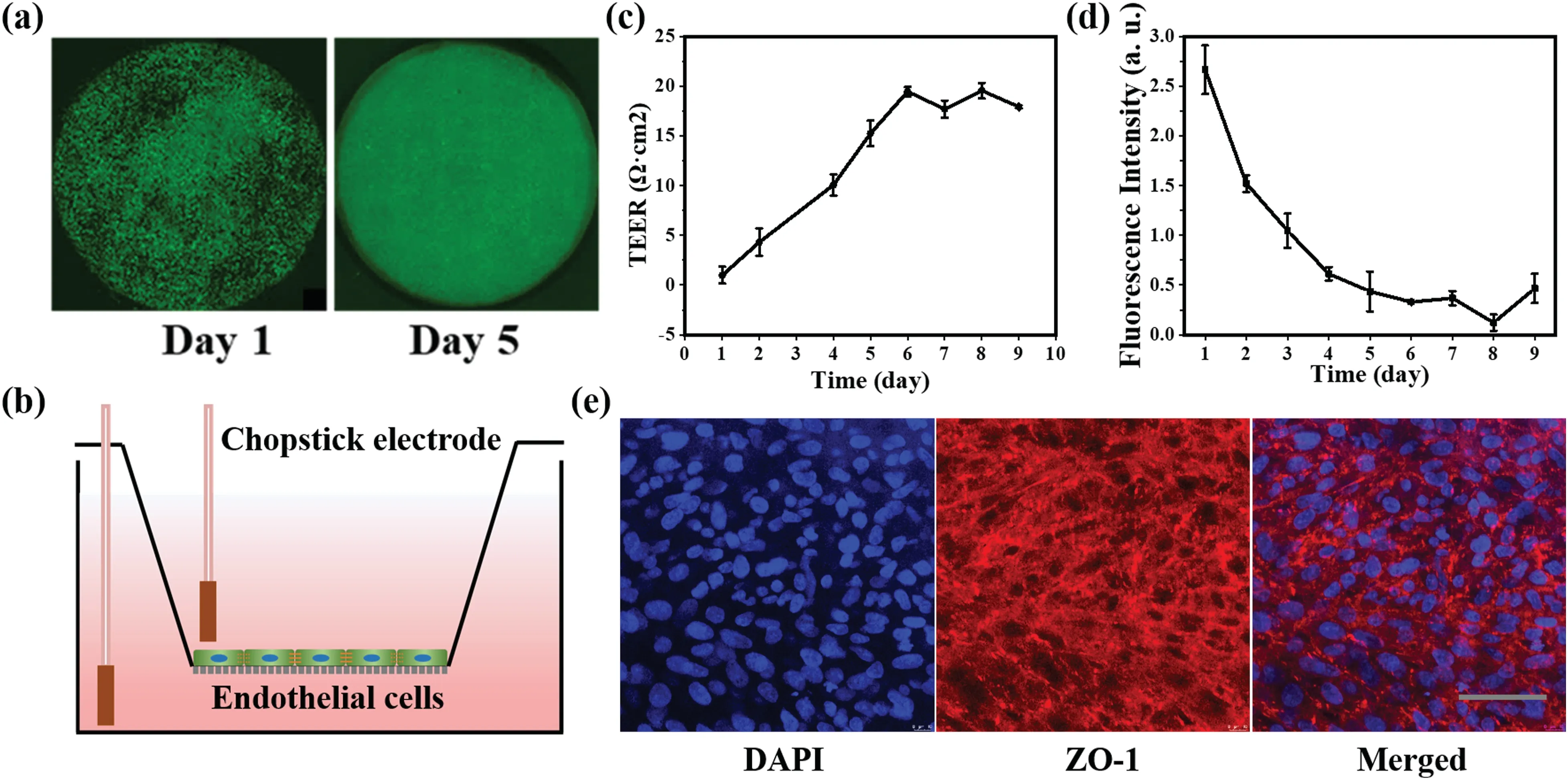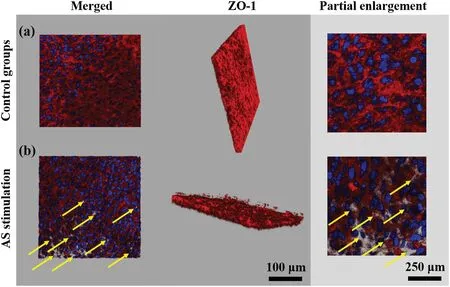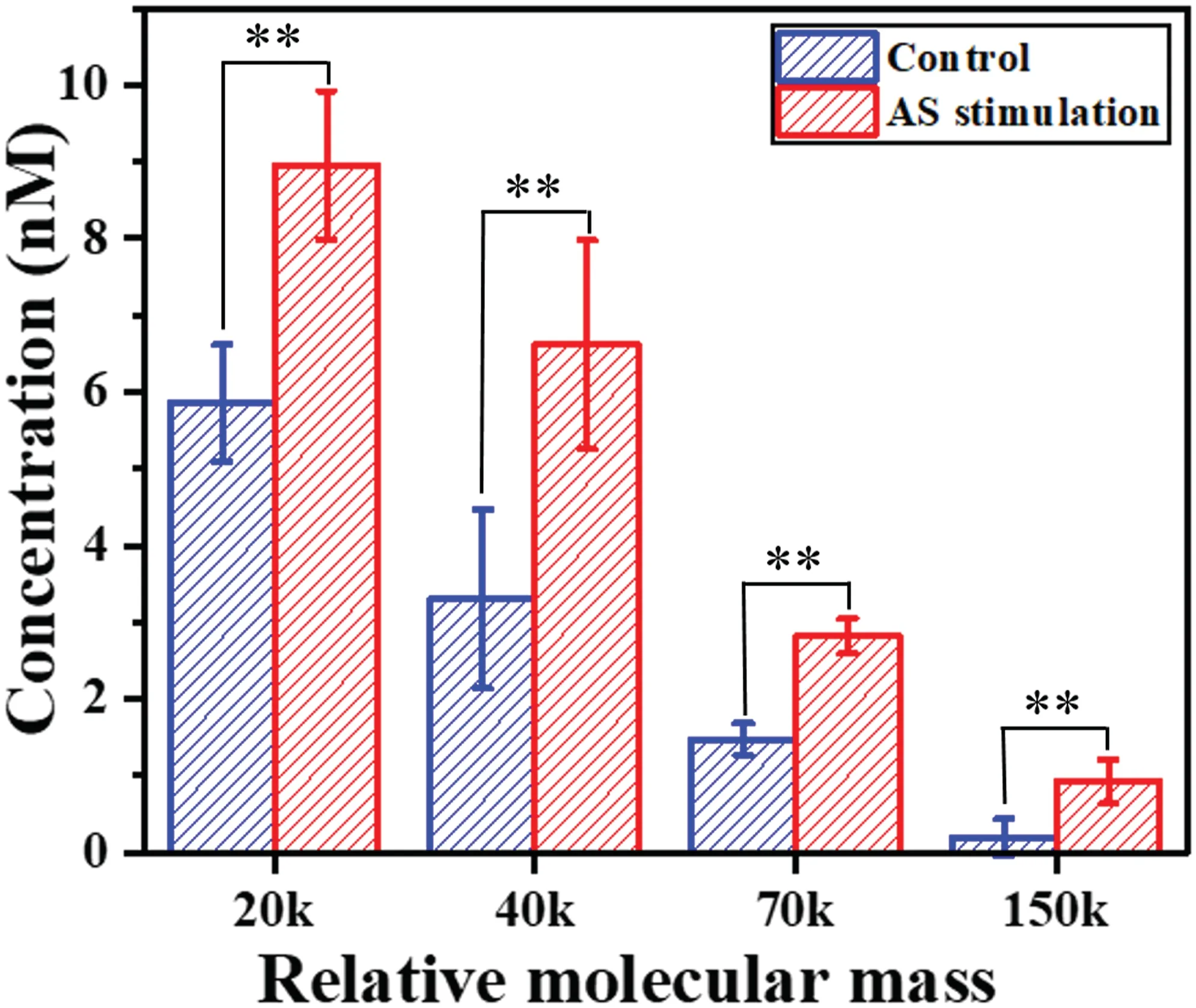Controllable blood–brain barrier(BBB)regulation based on gigahertz acoustic streaming
Hang Qi,Shuaihua Zhang,Jiaxue Liang,Shan He,and Yanyan Wang
ABSTRACT The blood–brain barrier(BBB)is a structural and functional barrier necessary for brain homeostasis,and it plays an important role in the realization of neural function and in protecting the brain from damage by circulating toxins and pathogens.However,the extremely dense BBB also severely limits the transport of molecules across it,which is a great hindrance to the diagnosis and treatment of central nervous system(CNS)diseases.This paper reports a new method for controllable opening of the BBB,based on the gigahertz acoustic streaming(AS)generated by a bulk acoustic wave resonant device.By adjusting the input power and working distance of the device,AS with tunable flo rate can be generated to disrupt tight junction proteins(TJs)between endothelial cells.The results obtained with this method show that the gigahertz AS promotes the penetration of dextran molecules with different molecular weights across the BBB.This work provides a new platform for studying the mechanical regulation of BBB by flui shear forces and a new method for improving the efficienc of drug delivery.?2022 Author(s).All article content,except where otherwise noted,is licensed under a Creative Commons Attribution(CC BY)license(http://creativecommons.org/licenses/by/4.0/).https://doi.org/10.1063/10.0014861
KEYWORDS Blood–brain barrier,Mechanical regulation,Drug delivery,Bulk acoustic wave,Acoustic streaming
I.INTRODUCTION
The blood–brain barrier(BBB)constitutes the boundary of the cerebral blood vessels1and is a structural,functional,and physiological dynamic barrier composed of brain endothelial cells,pericytes,astrocytes,and basement membrane.2–6The BBB regulates the transport of ions,nutrients,and cells between the blood and the brain,2,7,8and it thus plays a critical role in the maintenance of homeostasis in the central nervous system(CNS).8–10At the same time,owing to the sizes of drug molecules and the effects of hydrophilicity,lipid solubility,and transduction pathways,the BBB prevents more than 98%of small-molecule drugs and 100%of macromolecular drugs from entering the CNS,11,12thus severely restricting CNS drug interventions and treatment of CNS-related diseases.13–17In recent years,techniques using nanoparticles,2,18–20ultrasonic cavitation,16,21,22and hypertonic solutions have been developed to help drug molecules bypass this barrier for delivery to the required sites for targeted therapy.23,24Among these techniques,nanoparticles increase circulation time by means of specificall designed composition,size,shape,and surface ligands,and they then cross the BBB through different surface strategies such as endocytosis.25Ultrasonic cavitation,on the other hand,uses the energy generated by oscillations of microbubbles under local ultrasonic irradiation to destroy the connections between endothelial cells and thereby allow trans-BBB delivery of drug molecules.26The principle of action of hypertonic solutions such as mannitol is the destruction of tight junction proteins(TJs)and adhesion proteins(AJs),with the consequent formation of pores in the BBB through which drug molecules can pass.27
In recent years,the regulation of BBB function and structure by the shear force generated by blood flo has attracted much attention.Fluid shear stress is considered to be a major stimulator of BBB differentiation and has a profound impact on maintaining the structural and functional integrity of the BBB.28Previous studies have found that when endothelial cells are subjected to flui shear stress,cell differentiation,proliferation,and cell cycle regulation are enhanced.29For example,Cucullo et al.30found that capillary shear stress(6.2 dyn/cm2)significantl upregulated the expression of TJs,AJs,drug transporters,and integrin-related genes,and significantl increased the content of cytoskeletal proteins,suggesting that flui shear forces can promote the development and maturation of the BBB.By contrast,abnormal levels of flui shear force can degrade the functional properties of the BBB.For example,Garcia-Polite et al.7found that a high level of shear stress(40 dyn/cm2)decreased the expression of TJs such as zonula occludens-1(ZO-1)and claudin-5 and changed their junction morphology.This indicates that the BBB will be damaged to a certain extent when the flui shear force is higher than the physiological shear force.
To facilitate the study of flui shear force regulation of the BBB and overcome the BBB impediment to molecular delivery,we use a solidly mounted thin-fil bulk acoustic wave resonator(SMR)that can generate acoustic streaming(AS)to construct a BBB mechanical regulation system with continuously adjustable shear force.Our experimental results show that the gigahertz AS generated by the SMR in liquid can achieve rapid regulation of the BBB and enhance molecular delivery across the BBB by interrupting the TJs between endothelial cells.
II.EXPERIMENTAL
A.Materials
A human cerebral microvascular endothelial cell line(hCMEC/D3)was obtained from Millipore Sigma.Endothelial cell medium(ECM)was obtained from ScienCell.Calcein-AM,Alexa Flour 594 ZO-1 monoclonal antibody(ZO1-1A12),4%paraformaldehyde,and Blocker bovine serum albumin(BSA)(10%)in PBS were purchased from Thermo Fisher Scientific Fluorescein isothiocyanate(FITC)-conjugated dextran(20 kDa,40 kDa,70 kDa,and 150 kDa)was obtained from Sigma-Aldrich.Phosphatebuffered saline(PBS,pH=7.4)and 4’,6-diamidino-2-phenylindole(DAPI)were obtained from Solarbio Life Sciences.Matrigel Basement Membrane Matrix Phenol Red Free and a 24-well Transwell were purchased from Corning Costar.
B.Equipment
The gigahertz-frequency SMR was fabricated by a microelectromechanical process.On the basis of past experience,31–33the acoustic resonator devices were fabricated on 100 nm undoped silicon(Si)wafers,starting with the deposition of aluminum nitride(AlN)and silicon dioxide(SiO2)layers alternately on the Bragg reflecto through physical vapor deposition(PVD)and chemical vapor deposition(CVD),respectively.Then,a sandwich structure comprising a bottom electrode(BE),a piezoelectric layer(AlN),and a top electrode(TE)was deposited and patterned layer by layer[Figs.1(b)and 1(c)].
C.Construction of model and monitoring of TEER
hCMEC/D3 cells were cultured in ECMat 37°C in a 5%CO2incubator:150μl of hCMEC/D3 cell suspension at a density of 1×105was evenly seeded in Transwell chambers coated with Matrigel in advance,and the ECMwas replaced every 24 h until the BBB model became mature.To monitor the growth of the BBB,its trans-endothelial electrical resistance(TEER)value was measured every 24 h by chopstick electrodes connected to a transmembrane resistance analyzer(EVOM2).

FIG.1.(a)Schematic ofthe principle ofAS regulation of the BBB.(b)Top-view micrograph of the gigahertz resonator.(c)Schematic of the verticalstructure of the gigahertz resonator.(d)Two-dimensionalFEM simulation of the velocity field generated by the SMR in liquid.The white arrows represent the direction ofthe AS.
D.System setup
The microelectromechanically fabricated SMR was diced to a side length of 2 mm and then fixe on top of a slender electronic vacuum booster(EVB)board,with communication provided through gold wires.The SMR device thus constructed was vertically fixe on a three-axis displacement stage(with one end of the SMR device downward)and inserted into Transwell chambers cultured with the BBB model.The input power was controlled through a sinusoidal signal generated by a signal generator and amplifie by a power amplifier The distance between the SMR device and BBB model was controlled to be 1.5 mm by adjusting the Z axis of the displacement stage.Input signals of different powers(300 mW,400 mW,and 500 mW)were then applied to the SMR through the signal generator,with the time of each action being controlled at 10 min.
E.Measurement of molecular penetration across the BBB
The cell culture mediumin the Transwell chamber was replaced with a solution of dextran conjugated with FITC,and the dextran molecules permeated across the BBB and accumulated in the lower chamber.After standing for 10 min,the solution in the lower chamber was collected,and its fluorescenc intensity was measured with a microplate reader(Varioskan LUX)to characterize the molecular permeability.The emission spectrum of the collected solution under excitation light of 488 nm was measured with a microplate reader.To accurately obtain the fluorescenc intensity of the solution,this was taken to be the average value of the fluorescenc intensity corresponding to wavelengths in the range of 515–525 nm:the spectrum of each group was scanned twice with two wells and the average was then calculated.Three replications were performed for each molecular weight probe.To obtain the concentration of the solution from the measured fluorescenc intensity,the original dextran solution was diluted by gradient and the fluorescenc intensity was measured to obtain a calibration curve corresponding to concentration and fluorescenc intensity.The fluorescenc intensity of the collected solution was measured according to the calibration curve to obtain its molecular concentration.
F.Immunofluorescence staining
Cells were fixe with 4%paraformaldehyde solution for 10 min,followed by treatment with 0.25%TritonX-100 for 25 min to permeabilize them.Then,after blocking with 5%BSA for 1 h,ZO-1 monoclonal antibody conjugated with a red fluorescen molecule(1:200 in 1%BSA)was added and incubated at room temperature for 3 h.The nuclei were finall counterstained with DAPI for 20 min.At the end of each step,the samples were washed three times with PBS for 3 min each.After staining,fluorescenc micrographs were taken with a confocal microscope(Leica TCS SP8)for analysis and observation.
G.Statistical analysis
The experimental data are expressed in the form of mean±standard deviation,and each group of experiments has four replicates.The fluorescenc intensity of the images was obtained by ImageJ software.

FIG.2.Two-dimensionalFEM simulation of AS velocity induced by the SMR at differentdistances(500μm,1000μm,and 1500μm)from the SMR.
III.RESULTS AND DISCUSSION
A.Effect of acoustic streaming on BBB integrity
The SMR consists of two electrodes with a piezoelectric layer(AlN)sandwiched between them.When an external electric fiel is applied through the electrodes,the piezoelectric material induces mechanical vibrations due to the inverse piezoelectric effect.The resonant frequency of the SMR designed for this experiment is 1.58 GHz,When the SMR is operating in a liquid,gigahertz AS is generated[Fig.1(a)].A two-dimensional finit element simulation(FEM)of AS was performed,as shown in Fig.1(d),where the white arrows indicate the direction of the liquid flow It can be seen that when the SMR is active in the liquid,dissipation of acoustic energy induces AS,which flow down from the middle and back from both sides,thus producing a vortex-like streaming in the liquid.
The different shear forces that can be generated by the gigahertz AS were also verifie by FEM simulation.The flo rates of this streaming at different distances from the SMR(Fig.2)(500μm,1000μm,and 1500μm)were simulated.The results show that the velocity of the AS is greater at locations closer to the SMR.The mechanical force imposed on the cells by the AS at the solid–liquid interface is caused by the sharp reduction of the velocity to zero.31Therefore,the closer the cells are to the SMR,the greater is the mechanical force that can be applied.Thus,the distance between the SMRand the cell can be controlled by the Z axis to produce a specifi magnitude of force imposed on the cell.
The effect of the gigahertz AS on BBB integrity was firs investigated.To visualize the changes in the endothelial cells layer,hCMEC/D3 cells were stained with calcein-AM(green fluorescence and observed with a confocal microscope.As shown in Fig.3(a),the distribution of endothelial cells was relatively dispersed on the firs day;then,after fiv days of culture,through continuous proliferation and confluence there were no obvious gaps between cells,and a dense cell barrier was thus formed.This suggested that the BBB model had formed a tight barrier of cells on the sixth day under these culture conditions.To more accurately monitor cell growth,the EVOM2 instrument was used to measure the TEER of the BBB models every 24 h[Fig.3(b)].TEER is a classical method to determine the integrity of the BBB,with a continuously increasing TEER value usually indicating continuous maturation of a BBB model.34The measurement results showed that the TEER values of the BBB models increased continuously over time and reached their highest value of 20Ωcm2on the sixth day,after which they stabilized over the following days[Fig.3(c)].This indicated that the integrity of the BBB improved over time and matured at day 6.A valid BBB model is thought to exhibit lower molecular penetration efficienc because of the restricted access to cellular pathways.34Therefore,to further follow the growth of the BBB models,the penetration of molecules across the barrier was also monitored using a solution of 20 kDa dextran conjugated with FITC,with the measurement results being shown in Fig.3(d).The fluorescenc intensity of the molecules that penetrated and accumulated in the lower chamber became weaker with time and stabilized around the minimum value at day 6.This indicated that the number of dextran molecules permeating across the barrier decreased with extended culture time,which indicates that connections between endothelial cells were gradually established in the BBB model,with a relatively dense and mature culture being achieved on the sixth day.It is known that the compactness of the BBB is due to the presence of TJs and AJs between endothelial cells,which significantl reduce paracellular permeability.ZO-1,one of the TJs,was selected to characterize the maturation of the BBB model on the sixth day of culture.We performed immunofluores cence staining of the BBB with the ZO-1 protein on the sixth day.The resulting immunofluorescenc images in Fig.3(e)show the expression of ZO-1 among endothelial cells.The above results all indicate that on the sixth day,a relatively mature BBB model had been established in the Transwell,enabling subsequent experiments to be carried out.
After the BBB models had been cultured to maturity(i.e.,after six days of culture),AS stimulation was applied to them using the SMR.A series of experiments were carried out to observe the effect of AS on the BBB.Different input powers(300 mW,400 mW,and 500 mW)were applied to the SMR to achieve different magnitudes of shear force on the BBB.To visualize the results,cells were fluorescentl stained with calcein-AM and then imaged using both fluorescenc and brightfiel confocal microscopy.As can be seen from both the fluorescenc and brightfiel images in Fig.4(a),at a SMR input power of 300 mW,the BBB integrity was not affected.However,when the power was increased to 400 mW,the fluorescenc intensity of the cells in the area affected by the AS decreased[indicated by the red arrows in Fig.4(a)],and the brightfiel image shows that the cells did not detach.It is speculated that the decrease in fluorescenc intensity may be caused by calcein-AM being pumped out of the cells under the action of the AS.With a further increase in input power to 500 mW,both the fluorescenc and brightfiel images show that the BBB was significantl damaged,some cells were peeled off from the substrate,and the integrity of the BBB was destroyed.As shown in Fig.4(b),measurements of the TEER value after AS stimulation with different input powers also reflecte this trend.The above results all indicate that the integrity of the BBB can be destroyed under higher-power AS but remains intact under lower-power AS.

FIG.3.(a)Fluorescence images of the BBB modelon the first and fifth days.(b)Schematic of the measurementofthe TEER value ofthe BBB model.(c)Measurementof TEER values ofthe BBB from day 1 to day 9.(d)Statistics of the fluorescence intensity in the lower chamber from day 1 to day 9(the fluorescence intensity ofthe solution in the lower chamber after the dextran solution had been added to the Transwellchamber and left for 10 min).(e)Immunofluorescence image of ZO-1 expressed by the BBB modelafter culture for 6 days.Scale bar=50μm.
B.Effect of acoustic streaming on tight junctions
Paracellular transport of molecules across the BBB is highly restricted mainly due to the presence of TJs and AJs between adjacent endothelial cells,which are critical for the maintenance of BBB structure and function.16To further explore the mechanism of the regulation of BBB by AS when the power of the SMR is 400 mW,a representative TJs,ZO-1,was selected to study its changes under AS stimulation.The ZO-1 protein was stained with a ZO-1 monoclonal antibody conjugated with a red fluorescen molecule,and three-dimensional layer scanning was performed with a confocal microscope to obtain three-dimensional fluorescenc images.As can be seen from Fig.5(a),when there was no AS stimulation,ZO-1 protein in the BBB fille the gaps between cells to form a tight barrier.However,Fig.5(b)shows that when 400 mWAS was applied to the BBB,the ZO-1 protein between cells was disrupted and pores appeared between cells.From the perspective of TJs,this experiment proves that AS can increase the penetration of molecules by reducing the integrity of the BBB.

FIG.4.(a)Fluorescence and brightfield images ofBBB models under AS with different powers.The red arrows indicate the site of the BBB stimulated by AS.Scale bar=500μm.(b)Changes in TEER of BBB models after AS stimulation.

FIG.5.Effect of AS on ZO-1.The red fluorescence represents ZO-1,and the blue fluorescence represents the nucleus.The controlgroups in(a)were not subjected to any treatment,whereas the experimentalgroups in(b)were subjected to 400 mW AS stimulation for 10 min.The yellow arrows in(b)indicate the pores generated in the BBB under the action of the AS.

FIG.6.Concentration of dextran ofdifferentmolecular weights that penetrated through the BBB into the lower chamber.The experimentalgroups were stimulated with 400 mW AS,whereas the controlgroups did notreceive any treatment.**p<0.01.
C.Effect of acoustic streaming on molecular penetration across the BBB
The ability of drug molecules to cross the BBB is crucial for therapy of CNS diseases.However,existing methods for transporting drugs across the BBB are often complex,with severe side effects in some cases.13The discovery in the above experiments that AS can create pores between dense endothelial cells by interrupting TJs suggests that this effect could be used to enhance the penetration of molecules across cellular barriers.Dextran molecules with different molecular weights(20 kDa,40 kDa,70 kDa,and 150 kDa)conjugated with FITC were selected for trans-BBB penetration experiments in which the concentration of dextran that penetrated through the BBB from the upper chamber and accumulated in the lower chamber within 10 min was measured.As can be seen from Fig.6,when there was no AS stimulation,the higher the molecular weight of the dextran,the fewer molecules penetrated into the lower chamber across the BBB,which is consistent with the previous understanding that the BBB is selective to molecular size of the molecule:the larger the molecular weight of a molecule,the less likely it will be to penetrate.At a molecular weight of 150 kDa,almost no molecules penetrated through the BBB into the lower chamber in the control group without stimulation.By contrast,in the experimental group,under stimulation by 400 mW AS,about 1 nM of 150 kDa dextran molecules penetrated into the lower chamber within 10 min.For dextran with other molecular weights,the penetration in the experimental groups was also significantl better than in the control groups.This indicates that AS can promote the passage of molecules across the BBB.The promotion of molecular penetration across the BBB by AS provides a new way to solve the problem of how to deliver drugs into the brain to treat diseases.
IV.CONCLUSION
Overall,this work has demonstrated that controllable AS generated by a gigahertz bulk acoustic wave resonator device is an effective tool to regulate the BBB and facilitate the delivery of molecules across it in a controllable manner.The experimental results confir that the integrity of the BBB can be regulated by adjusting the input power of the resonator to generate controllable AS.This AS can facilitate molecular penetration across the BBB by interrupting TJs and thereby creating pores in the BBB.Since the resonator can generate AS of controllable magnitude and also facilitates miniaturization,this approach provides a new platform for studying the regulation of the BBB by shear forces,as well as a new method for effectively promoting the delivery of drug molecules across the BBB.
ACKNOWLEDGMENTS
The authors acknowledge financia support from the National Natural Science Foundation of China(Grant No.61971302).
AUTHOR DECLARATIONS
Conflict of Interest
The authors have no conflict to disclose.
Author Contributions
Y.W.conceived the idea and designed the experiments.H.Q.performed the experiments and analyzed the results.S.Z.performed the simulation.S.H.and J.L.contributed to the editing of the paper.H.Q.and Y.W.wrote the paper.
DATA AVAILABILITY
The data that support the finding of this study are available from the corresponding author upon reasonable request.
- 納米技術(shù)與精密工程的其它文章
- A new approach for accurate determination of particle sizes in microfluidic impedance cytometry
- Conductive polymer hydrogel-coated nanopipette sensor with tunable size
- Multi-temperature modeling of femtosecond laser pulse on metallic nanoparticles accounting for the temperature dependences of the parameters
- Demands and technical developments of clinical flow cytometry with emphasis in quantitative,spectral,and imaging capabilities

